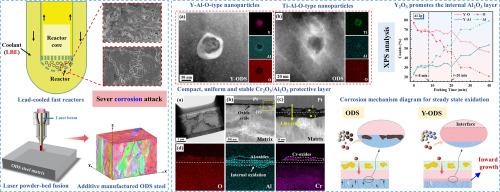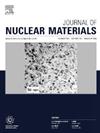添加剂制造的 ODS-FeCrAl 钢在铅铋共晶(LBE)中实现了高抗腐蚀性能
IF 2.8
2区 工程技术
Q3 MATERIALS SCIENCE, MULTIDISCIPLINARY
引用次数: 0
摘要
开发用于铅铋共晶(LBE)的耐腐蚀合金对铅冷快堆至关重要。在这项工作中,应用快速成型技术制造了氧化物分散强化铁铬铝钢(ODS 和 Y-ODS),后者含有 1.5 wt.% 的 Y2O3 纳米颗粒。这两种合金在 450 °C 的 LBE 中暴露 1000 小时后,都会产生一层紧密、均匀和稳定的 Cr2O3/Al2O3 保护氧化层(低于 200 nm)。得益于初始阶段的快速瞬时氧化速率,氧化层实现了缓慢的氧化动力学,对 LBE 侵蚀具有很高的耐腐蚀性。更重要的是,Y2O3 的添加会诱导 Y-Al-O 型氧化物纳米颗粒的形成,从而在界面上提供额外的 Al3+ 源,并促进 Al2O3 内部氧化层的生长,因此氧化层具有显著的稳定性。这项研究凸显了增材制造在低熔点炉衬先进材料中的潜在应用。本文章由计算机程序翻译,如有差异,请以英文原文为准。

Additive manufactured ODS-FeCrAl steel achieves high corrosion resistance in lead-bismuth eutectic (LBE)
Developing corrosion resistant alloys used in lead-bismuth eutectic (LBE) is essential for lead-cooled fast reactors (LFRs). In this work, additive manufacturing was applied to fabricate oxide dispersion-strengthened FeCrAl steels (ODS and Y-ODS), and the latter contains 1.5 wt.% Y2O3 nanoparticles. After exposure in LBE at 450 °C for 1000 hours, both alloys generate a compact, uniform and stable Cr2O3/Al2O3 protective oxide layer (below 200 nm). Benefits from the quick transient oxidation rate at the initial stage, the oxide layer realizes a slow oxidation kinetics and achieves high corrosion resistance to LBE attack. More importantly, the addition of Y2O3 induce the formation of Y-Al-O-type oxide nanoparticles which provides an additional source of Al3+ at the interface and promotes the growth of an internal oxide layer within Al2O3, and thus subsequently the oxides layer demonstrates remarkable stability. This study highlights the potential application of additive manufacturing in advanced materials for LFRs.
求助全文
通过发布文献求助,成功后即可免费获取论文全文。
去求助
来源期刊

Journal of Nuclear Materials
工程技术-材料科学:综合
CiteScore
5.70
自引率
25.80%
发文量
601
审稿时长
63 days
期刊介绍:
The Journal of Nuclear Materials publishes high quality papers in materials research for nuclear applications, primarily fission reactors, fusion reactors, and similar environments including radiation areas of charged particle accelerators. Both original research and critical review papers covering experimental, theoretical, and computational aspects of either fundamental or applied nature are welcome.
The breadth of the field is such that a wide range of processes and properties in the field of materials science and engineering is of interest to the readership, spanning atom-scale processes, microstructures, thermodynamics, mechanical properties, physical properties, and corrosion, for example.
Topics covered by JNM
Fission reactor materials, including fuels, cladding, core structures, pressure vessels, coolant interactions with materials, moderator and control components, fission product behavior.
Materials aspects of the entire fuel cycle.
Materials aspects of the actinides and their compounds.
Performance of nuclear waste materials; materials aspects of the immobilization of wastes.
Fusion reactor materials, including first walls, blankets, insulators and magnets.
Neutron and charged particle radiation effects in materials, including defects, transmutations, microstructures, phase changes and macroscopic properties.
Interaction of plasmas, ion beams, electron beams and electromagnetic radiation with materials relevant to nuclear systems.
 求助内容:
求助内容: 应助结果提醒方式:
应助结果提醒方式:


